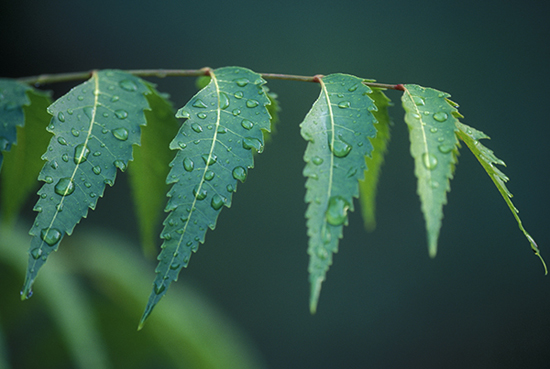
Name: Neem Leaf (Azadirachta indica)
Evergreen
Family: Meliaceae
Common Names: Sarva Roga, Nivarini, Indian Lilac, Heal All, Village Pharmacy
Range: Native to India, Pakistan, Bangladesh, Sri Lanka, East Africa. Neem is also cultivated in various parts of the world, including the southeastern U.S.
Parts Used: Dried leaf, powdered leaf, oil extracted from the seeds
Preparations: The oil is used neat (direct and undiluted). The fresh leaf is used to make tinctures. The dried, powdered leaf is made into tea or formulated into ointments, creams, and other topical applications.
History: Neem has played an important role in Indian culture and Ayurdevic medicine for centuries, where it is still commonly referred to as the “village pharmacy” and “healer of all ailments.” East Africans know this evergreen tree as Mwarobaini, which translates from Swahili to mean, “the tree of the 40,” in reference to earning a reputation for curing 40 different disorders.
The leaf and seed possess multiple medical properties, including being antibacterial, antiviral, antifungal, and anthelmintic. Neem is particularly useful in treating viral and bacterial infections and fever. Practitioners of Ayurvedic medicine often recommend neem for a variety of skin disorders, such as acne. In fact, neem extracts are incorporated into soaps, shampoos, lotions, creams, and ointments. In some parts of the world, neem is considered useful in preventing outbreaks of malaria and chicken pox. The young twigs of the tree are collected and sold as dental aids to help prevent the development of gum disease. Other applications of neem have historically included glucose management in diabetes. There is also sufficient evidence to suggest that neem may possess contraceptive properties.
There are several biological activities that neem appears to initiate that have been well documented in more than 500 clinical trials and studies. For example, neem compounds promote glutathione utilization, which helps the liver to detoxify the body of environmental toxins. Preparations formulated to treat skin disorders provide long-chain fatty acids to soothe irritations, as well as antioxidants to promote healing and cellular renewal. Neem also supports the immune system by stimulating an increased production of white blood cells and T-cells.
Neem has great potential in terms of environmental conservation. As a vigorous and hardy growing tree that is highly resistant to heat and wind, it holds promise as a means to reforestation in many parts of the world while supplying economic stability to these regions at the same time. Neem is also considered a “soft” pesticide, so-called because it deters damage from pests but without negatively impacting the surrounding environment or wildlife. For that matter, neem doesn’t even kill pests, at least not directly. Instead, compounds in neem interrupt certain biological processes in at least 500 species of insects, rendering them unable to feed or reproduce. In humans, neem is effective against parasitic infestations from head lice and scabies mites, as well as intestinal worms. The oil is commonly used in sprays to deter fleas in cats and dogs, as well as in organic gardening pest control products. However, it should be noted that neem products are detrimental to bees and should not be applied during hours they are likely to be active around flowers and plants.
Constituents: Nimbin, nimbidin, nimbinene, quercetin, and azadirachtin (seeds)
Cautions/Contraindications: Should not be used by pregnant or nursing women.
Disclaimer: This information has not been evaluated by the U.S. Food and Drug Administration and is not intended to diagnose, treat, cure, or prevent any disease.
Buy neem leaf